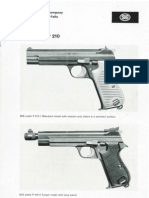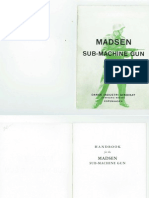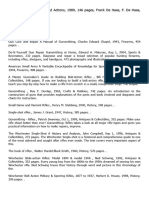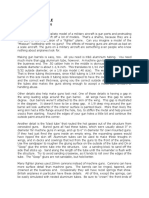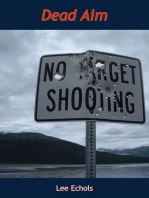100%(1)100% found this document useful (1 vote)
726 viewsOSS Silenced Pistol
OSS Silenced Pistol
Uploaded by
steved_43OSS HiStandard Model HDM silenced pistol was, without doubt, the most popular and widely used of all the OSS clandestine weapons systems. OSS Silenced Pistol is a faithfully executed re-creation of a historically important clandestine weapon. To fully understand the development and history of the OSS Silenced Pistol a knowledge of two organizations is essential.
Copyright:
Attribution Non-Commercial (BY-NC)
Available Formats
Download as PDF, TXT or read online from Scribd
OSS Silenced Pistol
OSS Silenced Pistol
Uploaded by
steved_43100%(1)100% found this document useful (1 vote)
726 views5 pagesOSS HiStandard Model HDM silenced pistol was, without doubt, the most popular and widely used of all the OSS clandestine weapons systems. OSS Silenced Pistol is a faithfully executed re-creation of a historically important clandestine weapon. To fully understand the development and history of the OSS Silenced Pistol a knowledge of two organizations is essential.
Copyright
© Attribution Non-Commercial (BY-NC)
Available Formats
PDF, TXT or read online from Scribd
Share this document
Did you find this document useful?
Is this content inappropriate?
OSS HiStandard Model HDM silenced pistol was, without doubt, the most popular and widely used of all the OSS clandestine weapons systems. OSS Silenced Pistol is a faithfully executed re-creation of a historically important clandestine weapon. To fully understand the development and history of the OSS Silenced Pistol a knowledge of two organizations is essential.
Copyright:
Attribution Non-Commercial (BY-NC)
Available Formats
Download as PDF, TXT or read online from Scribd
Download as pdf or txt
100%(1)100% found this document useful (1 vote)
726 views5 pagesOSS Silenced Pistol
OSS Silenced Pistol
Uploaded by
steved_43OSS HiStandard Model HDM silenced pistol was, without doubt, the most popular and widely used of all the OSS clandestine weapons systems. OSS Silenced Pistol is a faithfully executed re-creation of a historically important clandestine weapon. To fully understand the development and history of the OSS Silenced Pistol a knowledge of two organizations is essential.
Copyright:
Attribution Non-Commercial (BY-NC)
Available Formats
Download as PDF, TXT or read online from Scribd
Download as pdf or txt
You are on page 1of 5
‘The OSS HiStandard
Model HDM silenced
pistol was, without
doubt, the most popu-
lar and widely used of
|| allthe OSS clandestine
‘weapons systems.
Visit us on ine at woe snamareview ont
OSS Silenced Pistol
Text and photos
by Peter G. Kokalis
During the American Civil War,
Abraham Lincoln approached the scien
tific community and asked their support
in the development of new weapon sys-
toms, It was for this purpose that the
American Academy of Sciences was es-
tablished, Subsequently, the National De-
fense Council of World War [continued
efforts to work with the military inthe de-
velopment of military technology. As a
consequence of inadequate funding and
leadership atthe highest levels, the results
were minimal
PPriorto our involvementin World War
IL the NDRC was established to comple-
‘ment the research of the Army and Navy
inthe development of the instrumentali-
ties of war.” Eventually the NDRC was
Right: The Arms Tech Ltd. OSS Si
enced Pistol, shown here with a
black Minox Model C spy camera,
isa faithfully executed re-creation
‘of a historically important clandes-
‘tine weapon.
To fully understand the development and history of the OSS
HiStandard silenced pistol a knowledge of two organizations is es-
sential: the National Defense Research Committee (NDRC), under
whose auspices it was developed, and Office of Strategic Services
(OSS), for whom it was developed.
‘made a branch of the OF-
fice of Scientific Research
and Development (OSRD).
‘Throughout the war, the
British- who hadextensive
knowledge of the German
arsenal and appropriate
‘countermeasures - cooper
ated with the NDRC and
shared both research and.
experience. The final orga~
nizational structure of the
NDRC included nineteen
divisions and several spe-
cial committees and panels
The divisions covered re
search in a wide range of
topic areas, including. Bal:
listic research, Effects of
OSSSilenced Pistol, disassembled.
Impact and Explosion,
Rocket Ordnance, Ord-
nance Accessories, New Missiles, Subsur- 13 June 1942. Under the leadership of Col
William J."Wild Bill” Donovan, itwas an
Chemistry, Absorbents and Aerosols, operating agency the U.S. Governmentun-
Chemical Engineering, Transportation, der the control ofthe Joint Chiefs of Staff
lectical Communication, Radar, Radio and intended tobe of worldwide scope
Coordination, Opties and Camouflage, Donovan, who had previously held an im-
Physics, War Metallurgy and Applied portantintetigence postion and reported
Mathematics and Physics. Mostmystei- directly othe president, quickly pattemed
ousofall wasDivision 19, whichcovered OSS activities after those practiced by tl
““Miscellancous Weapons.” Formed to British Special Operations Executive
solve “special problems,” few of which (SOE), with whom the OSS worked clesly
evercame fromthe ArmyorNavy. Almost throughout the duration of the war.
allof Division 19s activites were devoted Donovan envisioned two majorroles for
tothe problems ofthe OSS and their Brit- the OSS: gathering intelligence and wag-
ishcounterpars ing clandestine warfare.
Jastsixmonthsafterthe United States To execute this dual role, Donovan
entered World War I, the Office of Stra- created anumber of branches with specii-
tegic Services (OSS) was established on _ cally defined objectives. The Research and
OSS SUPPRESSED “oni, 008
HIGH STANDARD 2329505 vote
PISTOL essere va
made.
___Handbook on the Weapon youmaypurcase the
re er O8S Patch only for
$10.95 or the Hand.
book on the Weapon
Sor only $24.95
ree Lae =
e-
‘S133 N, Central Ave.
Phoenix, AZ BS012
(602)272-9045
Fax (602)272-1922
(AL
SA ua.
20 The Small Arms Review «Vol § No.1 «August, 2002
Analysis Branch used the academic com:
munity to devise strategy for invasions
“The Morale Operations Branch generated
propaganda using professional advertising
copywriters and Hollywood screenwriters,
‘The Labor Branch promoted subversive
activity with labor unions in German-oc-
ceupied Burope. The Research and Devel
‘opment Branch, whose first director,
Stanley P. Lovell, was taken from the
NDRC staf, was in continual liaison with
Division 19 of the NDRC.
‘These latterbranches supported the
three main functional branches ofthe OSS,
‘They were Special Operations clandestine
warfare), Secret Intelligence (worldwide
gathering of intelligence through four geo-
‘graphical desks), and Counterintelligence
2,
‘By October 1943 the Research and
Development Branch had evolved into four
divisions. The Technical Division was r
sponsible for projectliaison between both
the NDRC and British SOE. The Docu-
‘mentation Division created all ofthe docu-
‘ments requiredto protectan agent's cover.
‘The Camouflage Division was established
tocamoutlage the personal accessories and
devices required for special operations
The Special Assistants Division provided
items for agents not within the purview of
the other three divisions.
Ttems developed for the OSS, in ad-
ition to the HiStandard Silenced Pistol in-
cluded the Liberator (nt originally an OSS.
weapon) .45 ACP single-shot pistol, the
22 caliber Stinger, the silenced 45 ACP
M3 submachine gun, edged weapons to
include the Stiletto and Smatchetcoss- sor. Tests at Aberdeen Proving Ground ACPColt*pocket pistols were unsuccess-
bovis, matchbox camera, lockpicking several months latercomparing thisunit ful, as Coltcould not provide them.
knife, suicide capsules, knockout drops with protypes ofasound-suppressed.45 During this same time frame, dsign-
andsabotageequipmentconsistingofin- ACP pistol, 30 MI Carbine and British ersatthe Rell Telephone Laboratories de-
cendiary, demolition, contact fring, de- 22 Welilencer were notsatisfactory. The veloped a sound suppressor attached ta
layedactionfringandharassing devices Colt Woodsman would fieinthe semi HiStandard pistol. Tests on this design
of many types. tomatic only with high velocity rounds, were very positive and Bell Telephone
Oneofthe mostsuccessfulandhighly The noise level was also quit disturbing. Laboratories waprovided witha contract
regarded wcaponseverdevelopedforthe Projctesmadcofoldandtungsen were 10 silence 110 pistols of various mates,
(OSS was the HiStandard Silenced Pistol. thentestedwithadrop inthe sound pres These ichided sixty sx Colt Woodsman
Surcly silenced firearm mustrateasthe sure level, butan increase in pressure to and Match Target pistols and forty four
highest possible priority forany clandes- excessive levels andan objectionable in-_HiStandardpistolsin Models A,B, Dang
tine operative creaseinsldeclater. Atemptsto obtain E,Bothshort and log bared types were
Very soon after the OSS was estab- longer bares forthe 32 ACP and 380 included inthe testing, Deliveries com
lished, agents used a.22 LR Colt Woods-
man equipped with an off-center sound
suppressor patterned afterthe Maxim, The MAG CINCH™
anithad a unique bare extension in front ena of se ea
ofthe suppressor with frontsight band See reas,
‘hat permited use ofthe pisto's standard dary to nog wih hg Me Eats
rear sight. The barel extension purport con oo eae g an
edly enhanced the weapon's accuracy po- imowo aera ma ih et
tential as well The offset design permit rood sonic
ted a larger suppressor for greatly im-
proved reduction ofthe sound pressure
level
Tn addition specimens of the original
Mazina sound suppressor were obtained
and tested, Both the Savage Arms Com-
anya the Sedgley Manufacturing Com-
Dany offered to produce them forthe OSS
fs manufacture had boon terminated in
1926 as aconsequence of feral egsia-
tion restricting theiruse and further rein-
forced by the National Firearms Act (NFA) sti WG BINH Focniniegaahew oper wir aes ergiabo ena
of 1934. However, it was obvious that then bo See 8 ore nt Tey wee MN REMC ka pee et
technology inthisarca had moved forward TreIVAG CINCH™ ures vl nomex sicher tr your msgs. Thay sre
anda completely new design was require. ge pec 3 ep agicines wou damage hey my — Ne
Thuson27 October 1942 sent twelve pro el axes you eaRZre Wo 288.
posalsto the planning board ofthe NDRC,
the first of which concerned the procure Aba hrs rhe AG CINCH: iy ele acs
ment of a weapon meeting the following Singe-Hotss ho azine secuevith aR CINCH
parameters: 1) silet,2) no flash signature, Deutle- Hea tooseiof sie tapers seni 8 WAC NCE
3) a minimum muzzle velocity of 1,000
fps, 4) preferably 50 ealiber and 5) a re- {Comore MoWRGCREH™ Systems roma ne AL, ANG, ARS, SRC,
loading of less than 30 seconds. A con- AIA BR Ak Madmen. MI-Catin, Wi, Kroc AY MB, USC, UM
twact for this research was given to the SLB, Shyer AUS. a Mow 308 sont FR-FAL)
Wester Blectric Company in New Jersey.
They were directed to develop a sound —— ES
suppressor with a) asound pressure level itu Tectrotger amo bs aco utr ard ceagned Ore
Jow enough to disguise the point of origin ‘Tochroerie lcuthn hs touma your bokared eeher exsalece dihg nme
a distance of 30 feet, b) minimum flash
signature, and adaptable to 45 ACP pis-
tols,the.30MI Garand ané Enfield rifles.
‘Three weeks after the contract was
signedi on 6 April 1943, Westem Electric
elivered asilenced Colt Woodsman tothe
ergo aachoye
Phone: (572) 824-2529 Butler Technologies
' Fax. (575)624-8522 P.O. Box 104903
(OSS that was very little more than a copy sales@buflertech.com Jelferson Cily, MO 45110
of the Polish Kulixowski sound suppres
The Small Arms Review «Vol § No.1 «August 2002 2
Silenced HiStandard HDM Disassembly Procedures
‘Disassembly and reassembly ofthe HiStandard HDM pistol is notentiely straight-
forward. First, remove the magazine and retract the slide to make certain the cham-
‘ber is empty. With the slide fully tothe rear, press down on the small, knurled
plunger on top of the slide. This locks and compresses both the recoil spring and its
‘guide rod, Allow the slide to move forward under control until you can rotate the
takedown latch -on the right side ofthe frame and to the rear of the hold-open
‘button - downward, while maintaining pressure on the plunger on top ofthe slide.
Keep holding the latch down while you retract the slide completely tothe rearand.
off the frame.
Depress the spring-loaded rear detent on the barrel until tclears the suppressor
tube. Rotate the suppressor tube to the right until ithas been removed from the
‘barrel, Withdraw the rear screen roll from the suppressor tube, The operator should
attempt no further disassembly of this system. Clean and lubricate lightly
Reassembly of the pistol is not possible unless the recoil spring and guide rod
remain locked and under compression. If the recoil spring and guide rod slip outof
the locked and compressed position, a small drift must be used to push them back
into their hole in the slide and then plunger pressed downward to make sure they
stay locked n place.
“Hold the hammer to the rear to clear the slide as the slide is placed on ts cuts inthe
frame, Hold the hammer rearward again as you push the slide fully forward. This
‘will release the recoil spring and its guide rod. Retract the slide to insure that it's
functioning properly. Re-insertthe suppressors rear sereen rol. Pushin the spring-
Toaded detent and thread the suppressor tube tothe leftuntiit's fully seated against
the frame,
‘menced in late October 1943. On 22.No-
vember 1943, the OSS Procurement
[Branch requesied that the Ordnance De-
partment award a contractto the High Stan-
Gard Manufacturing Company of New
Haven, Connecticut for 1,500 sound-sup-
pressed caliber 22 LR Model IED pistols,
(the US. Government designation fortis,
pistol was HDM). Deliveries on this con-
tract began 20 January 1944, The contract,
‘was completed on 10 October 1944, Re-
action tothe pistol by agents inthe fielé
was entirely favorable, One Thousand
more were ordered on 18 August 1944,
‘That contract was completed by 10 Octo-
ber 1944, Pistols completed in the first
contract featured a blued finish while those
of the second contract had a phosphate
(Parkerized”) finish. The suppressor tube
hhad a phosphate finish on both contracts.
InJuly 1944 someone noted that ac-
cording to The Hague Accord Regulations
(Article 23e) military personnel were not
permitted to employ small arms ammuni-
tion with unjacketed|
Donovan ordered uniformed military per-
sonnel to stop using the OSS silenced pis-
‘ols until jacketed ammunition was de
.dbullets, General
‘oped and issued. Civilian personnel were
permitted to continue deploying with the
‘weapon and most ofthe military person-
el either ignored or did not hear about
the order not to employ them, By 8 Febru-
ary 1945 20,000 rounds of jacketed T-42
22 LR ammunition was made available.
However, standard velocity Remington
ammunition with lexd projectiles eontin=
‘ued tobe issued and employed.
‘The HiStandard Model H-D .22 LR
pistolisaconventional blowback-operated
target pistol very much reminiscent ofthe
Colt Woodsman, Its main component
groups are: 1) the frame which forms the
grip and mounting required toreceive the
fixed barrel. It is machined to accept the
twigger mechanism and fitted with guides
for the reciprocating slide. 2) The barrel
is pinned to the frame. 3) The slide ex:
tends rearward from the breech and holds
the firing pin, extractor and recoil spring
assemblies. 4) The trigger group consists
of apivoting tigger witha side bar con-
necting ittothe sear, together with theap-
propriate springs and plangers,and an ex-
posed hammer attached to the mainspring
and plunger. 5) A sheet-metal 10-round,
single-line, detachable, box-type maga-
Zine, whichis interchangeable with that of
the Colt Woodsman,
Pushing the magazine catehreleaseon
the butt ofthe frame permits the magazi
tobe withdrawn, A loaded magazine isin-
ed and pushed in uni itlocks in plac
Subsequently pulling the slide tthe:
forces the hammer back and down which
compresses the mainspring, The sear
catches and holds the hammer back at full,
cock. Releasing the slide allows the com-
pressed recoil spring to drive the slide for-
‘ward, The face of the side is machined to
strip around from the magazine and drive
itintothe chamber. The extractor, located
‘on the tight side ofthe breech face then
snaps over the cartridge case’ im. When
the breech is completely in battery, the sear
bar, running from the trigger tothe sear on
the leftside ofthe frame, is brought into
contact with the sear
‘When the viggeris pressed, itpivots
‘and causes the sear har to release the sear
from the hammer, The mainspring then
drives the hammer forward to impinge
‘upon the firing pin, which then passes
through ahole inthe breechface to strike
the rimfire primer and also compress the
firing pin spring. As this spring rebounds,
itdraws the firing pin back intothe breech-
block. Rearward thrust ofthe propellant
gases forces the slide tothe rear. The slide
in turn rotates the hammer back to the
cocked position and compresses the main-
springas the sear holds the hammer inthe
cocked position. The slide also depresses
the sear bar so that another shot cannot be
fired until the tigger is released and the
slideis once again in the battery position,
During the recoil stroke, the extractor
draws the empty case rearward until it
strikes the ejector
‘The pistol is equipped with a frame-
‘mounted, manual thumb safety on the left
side. Rotating the serrated latch upward
bboth blocks the sear andengages anotch
inthe slide to prevent its rearward move-
‘The forward-sloping, fixed front sight
blade is serrated on its rear face. The open
square-notch rear sight is adjustable for
both elevation and windage zero. An in-
6x line milled into the slide is used for
alignment of the windage markson therear
sighthousing.
Overall length ofthe OSS HiStandard
Silenced Pistol 13.815 inches, The weight,
unloaded is 47 ounces. The barrel length,
The Small Arms Review «Vol § No.1 «August, 2002
Including the chamber, is 6.75 inches The
height ofthis pistol, withthe magazine in
place, is inches.
‘Overall length ofthe sound suppres-
soris 7.75 inches, including the 1/16-inch
thick end cap rim. The suppressor tube
serews onto the barrel where it emerges
from the frame, with detent locks on both
the barrel and forward end cap. The sup-
pressor tube hasan outside diameter of 1.0
inch, The rear scrcen roll surrounding the
barrel is 4.37 inches in length ang 0.795-
inch indiameter.Itismade of twenty-mesh,
tin-plated bronze screen soldered into a
tightly wound tube. The front screen disks
are made of thirty-mesh tin-plated bronze
and include approximately 110 disks
0.828 sinchin diameter, with about twenty
five having a0.410-inch hole so they can.
slip over the front of the barrel and there
‘mainder having a 0.234-inch hole. There
isa I/16-inch thick brass washer between
the rear sereen roll and the front disk
soreens that sO.828-inch in diameter with
4 0.410-inch hole. The sound pressure
level reductionofthissoundsuppressoris
in excess of 20 dB. This i excellent per-
formance for a silencer designed during
this time frame, i, six decades ago,
Today, examples of this incredible
piece of history are quite rare and there
are no more than a hancful in private col-
lections. Arms Tech Ltd (Dept. SAR, 5133,
North Central Avenue, Phocnix, AZ
85012; phone: 602-272-9045; fax: 602-
272-1922; e-mail: armstech@qwest.net),
already well known in the special opera
tions community for their special weap
onsand tactical equipment development,
has recreated this famous pistol ina man
rer authentic in every detail. Arms Tech
Led. can supply the entire OSS HiStandard
Silenced Pistol package - currently in in-
ventory and ready toshipafter ATF trans-
fer approval. The Arms Tech Ltd.
remanufacture of the OSS Hi-Standard
Silenced Pistol comes complete with a
‘manual, copy of the original U.S. Govern-
‘ment test report, replica OSS shoulder in-
signia and cross-section line drawing ofthe
pistol
‘The specimen sent to SAR for testand
evaluation was authentic in every detail
Theleft side ofthe slide was marked, “HI-
STANDARD MODEL H-D MILITARY”
and the entire pistol was provided with a
milspec phosphate finish, The original,
checkered, walnut grip panels were in ex-
cellent condition. The trigger pull weight
con our test specimen was a very crisp 3
pounds, which isundoubtedly agreatdeal Melton, II. Keith, 1991, OSS Special
lighter than the pistols issued tothe OSS Weapons & Equipment -Spy Devices of
in World War TL WWII, Sterling Publishing Company, Ine.,
‘Without doubt, the OSS Silenced Pis- 387 Park Avenue South, New York, NY
tolwasone of the mostpopularclandes- 10016, 128 p., black and white illustra-
tine weapons ever issued to U.S. opera- ‘ions.
Sves.One more prodictionrun wasmade i ci 1006. the Ukimate
forthe CIA after World War ll. These all Melton, H. Keit 1 Ukimate Spy
property markings. Ttwasusedthrough. Avenue, New York, NY 10016, 176 p.
colorand black and whit illustrations
‘utthe warin Vietnam with considerable
effect Oncofthese pistols Was foundo% trypy,y, David, 1972, Silencers Snipers
Rerpetariromnenaasy famine Acree
as shot down over Russia during. ing Death, Paladin Press, PO. BOx 1907,
ee itt ‘pe colt War Ams te Lid. Boulder, CO 80302, 210 p., black and
Isto be highly commended for bringing
back an incredibly fascinating piece of his
tory 1M-22-HI1, Technical, Operational and
References: ‘Maintenance Manual for.22 Caliber Pis-
tol, Silenced Hi-Standard Model HDM,
Brunner, John W., 1994, OSS Weapons, 2000, Phoenix Publishing Group, 4123
Phillips Publications, P.O. Box 168, North Longview, Phoenix, AZ. 85014, 85
Williamstown, NJ 08094-0168, 206 p.. p, black and whit illustrations
black and white illustrations, Bg
white illustrations
OSS HiStandard Silenced Pistol Spe
‘Overall length: 13.815 inches.
‘Weight, unloaded: 47 ounces.
Barrel length (including chamber): 6.75 inches.
Height: 5 inches with magazine i place
‘Magazine: 10-round, single-column, detachable box-type.
Suppressor specifications:
‘Overall length: 7.75 inches (including the 1/16-inch thick end cap rim), Suppres-
sortube serews onto the barrel where itemerges fromthe frame, with detent locks
‘on both the barreland forward end cap.
Diameter:
inch.
Interior suppressor dimensions: rear screen roll surrounding the barrel: 4.37
inches in length and 0.795-inch in diameter; wenty-mesh, tin-plated bronze screen
soldered into atightly wound tube, Front screen disks made of thirty-mesh,tin-
plated bronze and include approximately 110 disks 0.828-inch in diameter with
‘about 25 having a 0.410-inch hole so they can slip over the front of the barrel and
the remainder having a 0.234-inch hole, There isa 1/16-inch thick brass washer
‘between the rear sereen roll andthe front disk screens that is 0.828-inch in diam.
eter with a0.410 inch hole.
‘Suppression: In excess of 20 4B.
‘T&E Summary: A faithfully executed e-creation ofa historically important clan-
destine weapon,
The Small Arms Review «Vol § No.1 «August 2002 2
You might also like
- Millionaire Habits - How To Achieve Financial Independence, Retire Early, and Make A Difference by Focusing On Yourself FirstDocument240 pagesMillionaire Habits - How To Achieve Financial Independence, Retire Early, and Make A Difference by Focusing On Yourself Firststeved_43100% (1)
- The Space Shuttle Operator's ManualDocument160 pagesThe Space Shuttle Operator's Manualsteved_43No ratings yet
- SIG 210 ManualDocument6 pagesSIG 210 ManualJon MorenoNo ratings yet
- Bersa 380 Owners ManualDocument23 pagesBersa 380 Owners Manualglenn_allen_15No ratings yet
- Madsen M 50 ManualDocument14 pagesMadsen M 50 Manualsolid_alpha_1984100% (1)
- Ruger 10-22 Sniper RiflesDocument2 pagesRuger 10-22 Sniper RiflesPlainNormalGuy250% (2)
- Daewoo AR110CDocument20 pagesDaewoo AR110CJustin100% (1)
- STEN / 76: 9mm Sub Machine Gun SuppressorDocument6 pagesSTEN / 76: 9mm Sub Machine Gun SuppressorIngo Quander100% (1)
- TEPZZ 6 - 54Z A T: European Patent ApplicationDocument30 pagesTEPZZ 6 - 54Z A T: European Patent ApplicationJin SongNo ratings yet
- Baranov 1856 Six Line Rifle Musket PDFDocument2 pagesBaranov 1856 Six Line Rifle Musket PDFjgokey100% (1)
- More Single Shot Rifles and ActionsDocument20 pagesMore Single Shot Rifles and Actionsnhtan20200% (1)
- Maschinenpistole 40 (MP40) Submachine GunDocument7 pagesMaschinenpistole 40 (MP40) Submachine Gunblowmeasshole1911No ratings yet
- The 10mm Automatic - by Chuck HawksDocument2 pagesThe 10mm Automatic - by Chuck Hawksblowmeasshole1911No ratings yet
- Budischowsky Tp-70Document5 pagesBudischowsky Tp-70JustinNo ratings yet
- Lûëîßûäá., Patented July 8, 1913.: C6265 Z1' MEN@ MijnDocument6 pagesLûëîßûäá., Patented July 8, 1913.: C6265 Z1' MEN@ MijnyuehanNo ratings yet
- MP5 IpbDocument14 pagesMP5 IpbJulieth MahechaNo ratings yet
- Vortex 9Document12 pagesVortex 9255sectionNo ratings yet
- Chinese 67Document3 pagesChinese 67lowjack100% (1)
- SALW Guide: IWI Tavor TAR-21Document10 pagesSALW Guide: IWI Tavor TAR-21N'fast NgNo ratings yet
- P7 ManualDocument21 pagesP7 Manualjustin_j_gaudetNo ratings yet
- Franco-German 11mm Rifle0001Document1 pageFranco-German 11mm Rifle0001Ben Drusoy100% (1)
- The M14 Conversion To The M1 Garand: Version OneDocument13 pagesThe M14 Conversion To The M1 Garand: Version Oneleleva13No ratings yet
- Uzi Semi-Auto Carbine Fixed Stock Installation InstructionsDocument4 pagesUzi Semi-Auto Carbine Fixed Stock Installation Instructionselvergonzalez1No ratings yet
- RSTA Muzzle Brake / Flash Suppressor Mount Installation ManualDocument2 pagesRSTA Muzzle Brake / Flash Suppressor Mount Installation ManualGriffin Armament Suppressors0% (1)
- Glisenti Model 1910 SemiDocument4 pagesGlisenti Model 1910 SemiNikola AnticNo ratings yet
- How Semi-Automatic Pistols Function: The Greatest List of E-BOOKS On FirearmsDocument7 pagesHow Semi-Automatic Pistols Function: The Greatest List of E-BOOKS On Firearmsdwdw47No ratings yet
- Star Firestar PlusDocument12 pagesStar Firestar PlusSerteco Coleccionista MilitariaNo ratings yet
- Erma Manual I. JhonsonDocument8 pagesErma Manual I. Jhonsonp317No ratings yet
- VZ 58 Shell DeflectorDocument15 pagesVZ 58 Shell DeflectoromikamiNo ratings yet
- ZB 26 ManualDocument12 pagesZB 26 ManualWanmai NiyomNo ratings yet
- CarriageDocument25 pagesCarriageSamir SinghNo ratings yet
- MAS-38 Submachine Gun (France)Document4 pagesMAS-38 Submachine Gun (France)blowmeasshole1911No ratings yet
- m14 RasDocument4 pagesm14 RasSTGNNo ratings yet
- M1 GarandDocument12 pagesM1 GarandRob90100% (1)
- SPR Suppressor ManualDocument2 pagesSPR Suppressor ManualGriffin Armament Suppressors100% (2)
- 19th Century Carbine Manual 1Document35 pages19th Century Carbine Manual 1GustavNo ratings yet
- United States Patent: (12) (10) Patent N0.: US 7,261,029 B1Document9 pagesUnited States Patent: (12) (10) Patent N0.: US 7,261,029 B1apoorva singhNo ratings yet
- Japanese Ammunition IndexDocument7 pagesJapanese Ammunition Indexrobert_williamson_1No ratings yet
- Beginning Scale: Part 20 - Gun DetailingDocument2 pagesBeginning Scale: Part 20 - Gun DetailingjorgeNo ratings yet
- HK P7M13 Armorers ManualDocument33 pagesHK P7M13 Armorers ManualMichael Zeleny100% (1)
- The 1902 Model Colt Automatic PistolDocument10 pagesThe 1902 Model Colt Automatic Pistolblowmeasshole1911100% (1)
- Manual de La Barrett M95 CalibreDocument29 pagesManual de La Barrett M95 CalibreMB-RPNo ratings yet
- FN FAL Gas Block Conversion InfoDocument2 pagesFN FAL Gas Block Conversion InfoAdam HemsleyNo ratings yet
- Beretta U22 Neos PDFDocument0 pagesBeretta U22 Neos PDFab212amisarNo ratings yet
- AK Builder Rivet Tool InstructionsDocument4 pagesAK Builder Rivet Tool InstructionsDale WadeNo ratings yet
- Browning Machine Gun Cal .30 - Guns, Machine, Cal 30, Browning, Model 1919A4 Illustrated Identification List - 1942Document28 pagesBrowning Machine Gun Cal .30 - Guns, Machine, Cal 30, Browning, Model 1919A4 Illustrated Identification List - 1942ab212amisar100% (2)
- CETME HK G3 Compatibility PDFDocument3 pagesCETME HK G3 Compatibility PDFLIVE3ORDIENo ratings yet
- Punching Holes: Buying Ammunition, Gun Accessories, Knives and Tactical Gear at Wholesale PricesFrom EverandPunching Holes: Buying Ammunition, Gun Accessories, Knives and Tactical Gear at Wholesale PricesNo ratings yet
- Hints on the Use and Handling of Firearms Generally, and the Revolver in ParticularFrom EverandHints on the Use and Handling of Firearms Generally, and the Revolver in ParticularRating: 5 out of 5 stars5/5 (1)
- Practical Guide to the Operational Use of the PPS-43 Submachine GunFrom EverandPractical Guide to the Operational Use of the PPS-43 Submachine GunNo ratings yet
- Gun Digest American Arms ATI GSG-5 Assembly/Disassembly InstructionsFrom EverandGun Digest American Arms ATI GSG-5 Assembly/Disassembly InstructionsNo ratings yet
- The Development of Armor-piercing Shells with Suggestions for their ImprovementFrom EverandThe Development of Armor-piercing Shells with Suggestions for their ImprovementNo ratings yet
- Practical Guide to the Operational Use of the TT-33 Tokarev PistolFrom EverandPractical Guide to the Operational Use of the TT-33 Tokarev PistolRating: 5 out of 5 stars5/5 (2)
- Building or Restoring Your Muzzleloader: Making Muzzleloaders from Kits and Damaged GunsFrom EverandBuilding or Restoring Your Muzzleloader: Making Muzzleloaders from Kits and Damaged GunsRating: 5 out of 5 stars5/5 (1)
- Practical Guide to the Operational Use of the M79 Grenade LauncherFrom EverandPractical Guide to the Operational Use of the M79 Grenade LauncherNo ratings yet
- Your Unofficial Kindle Fire ManualDocument38 pagesYour Unofficial Kindle Fire Manualsteved_43No ratings yet
- Winning With Millennials - Turning Your Greatest Challenges Into Your Greatest StrengthsDocument21 pagesWinning With Millennials - Turning Your Greatest Challenges Into Your Greatest Strengthssteved_43No ratings yet
- Xxi 3 Honda h51 HDJT o Afm r2 3mar2017Document712 pagesXxi 3 Honda h51 HDJT o Afm r2 3mar2017steved_43No ratings yet
- Marilyn Morgan - Baffling Murder Mysteries-Loompanics Unlimited (2001)Document196 pagesMarilyn Morgan - Baffling Murder Mysteries-Loompanics Unlimited (2001)steved_43No ratings yet
- Claire Wolfe - Don't Shoot The Bastards (Yet) - 101 More Ways To Salvage Freedom-Loompanics Unlimited (1999)Document260 pagesClaire Wolfe - Don't Shoot The Bastards (Yet) - 101 More Ways To Salvage Freedom-Loompanics Unlimited (1999)steved_43100% (1)
- A Professional's Guide To PyrotechnicsDocument68 pagesA Professional's Guide To Pyrotechnicstdfbzbfded100% (5)
- Philip D. Harvey - Government Creep - What The Government Is Doing That You Don't Know About-Loompanics Unlimited (2003)Document171 pagesPhilip D. Harvey - Government Creep - What The Government Is Doing That You Don't Know About-Loompanics Unlimited (2003)steved_43100% (1)
- Biomass Pyrolysis OilsDocument409 pagesBiomass Pyrolysis Oilssteved_43No ratings yet
- SAAMI Generally Accepted Firearms and Ammunition Interchangeability 10-8-2021Document3 pagesSAAMI Generally Accepted Firearms and Ammunition Interchangeability 10-8-2021steved_43No ratings yet
- SAAMI Z299.3 2022 Centerfire Pistol Revolver Approved 12-13-2022 1Document181 pagesSAAMI Z299.3 2022 Centerfire Pistol Revolver Approved 12-13-2022 1steved_43No ratings yet
- Info Doc Smokeless Powder 11-8-2022Document5 pagesInfo Doc Smokeless Powder 11-8-2022steved_43No ratings yet
- Excel Keyboard ShortcutsDocument1 pageExcel Keyboard Shortcutssteved_43No ratings yet
- Design Principles of Excel DashboardDocument17 pagesDesign Principles of Excel Dashboardsteved_43No ratings yet


